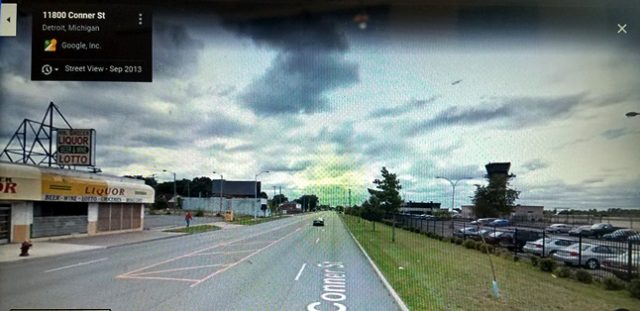
Site of 2004 “Black Party” where Jamal Segars was killed; area was filled with pedestrians and bumper-to-bumper traffic.
Evidentiary hearing in case against Thelonious Searcy proceeds May 15
Invalid jury instructions re: ballistics
Testimony that police fired guns, contradicting officers’ reports at trial
Letter from Corp. Counsel re: second fatality at the scene never investigated
By Diane Bukowski
May 16, 2018
Update April 20, 2021: DeAnthony Witcher, referenced in stories on Thelonious Searcy case, stated in a phone call to VOD Editor Diane Bukowski that he is NOT a police informant and denies all allegations made against him in this and subsequent stories on the Thelonious Searcy case.
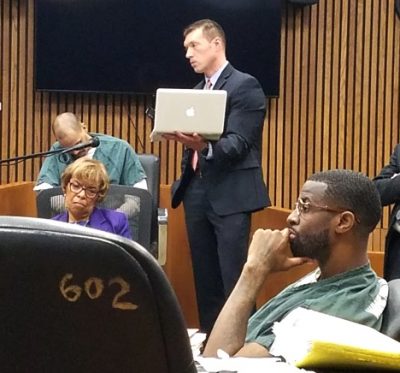
Thelonious Searcy (r, seated) listens as his attorney Michael Dezsi plays Vincent Smothers’ confession into the record March 19. Smothers is on stand with head bowed.
DETROIT – In addition to Vincent Smothers’ confession on the stand to the murder of Jamal Segars during a Sept. 4, 2004 “Black Party” outside Detroit City Airport, other stunning discrepancies in the prosecution’s case at trial against Thelonious Searcy surfaced during the fourth part of his evidentiary hearing May 15.
Searcy’s defense attorney Michael Dezsi exposed the following key factors during examination of prosecution and police department witnesses, which conformed with Smothers’ account on March 19:
- Confirmation of the presence of a 9 mm shell casing at the scene, not noted at trial;
- Invalid jury instructions given at trial that the bullets found in Segars’ body were too deformed for identification;
- Confirmation that two .40 caliber bullets were obtained from Segars’ chest and neck by the medical examiner;
- Witness testimony that police fired their guns at a “a driver,” not raised at trial, contradicting officers’ trial testimony that did not fire their weapons;
- A law department memo referencing another fatality at the scene, in a burgundy Marauder which sped off to an unknown location after colliding with a police car;
- A police report confirming the collision, not raised at trial or further investigated by DPD.
- Witness confirmation of the collision and police gunfire.
Assistant Prosecutor Timothy Chambers asked Sgt. Patricia Little, a “prosecuting detective” from the Wayne County Prosecutor’s Office, about the bullet from a sealed envelope examined in her presence at the Michigan State Police crime lab during an inspection Judge Timothy Kenny ordered earlier.
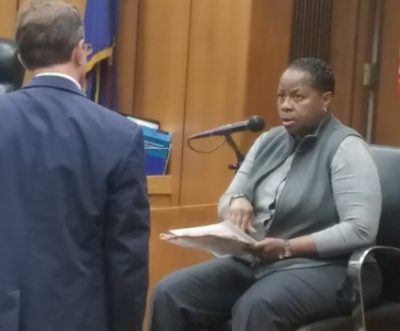
AP Timothy Chambers questions Pros. Det. Patricia Little May 15
“The tag on the envelope said it was bullet 04-08114, removed from the deceased Jamal Segars by Drs. Schmidt and Gupta,” Little read. “The date of the autopsy was Sept. 6, 2004, and it was removed from [Segars] chest.”
She also testified to the medical examiner’s discovery of a second bullet in Segars’ neck. Both were later identified as .40 caliber bullets.
On cross-exam, Dezsi presented a note from trial judge Timothy Kenny responding to a trial jury inquiry about what caliber bullet(s) were found in Segars’ body.
“Now with regard to your first question about what type of caliber of bullet was found in the deceased. After speaking with the attorneys, they have agreed to my sharing with you that the bullets recovered from the deceased were too deformed to identify what gun they came from or what caliber bullet they were.”
Dezsi asked Little, “Do you agree that the bullet you brought here today has since been identified and labeled as a .40 cal bullet? Would you agree that telling the jury we don’t know presents a discrepancy from what we see?”
After Chambers’ objection, Little did not respond.
Smothers testified March 19 that he killed Segars with multiple shots using a .40 caliber gun, and that his accomplice Jeffery Daniels approached Segars’ silver Corvette from the passenger side with a .45 caliber gun, but fired it into the air. An investigator’s report from the scene corroborates that:
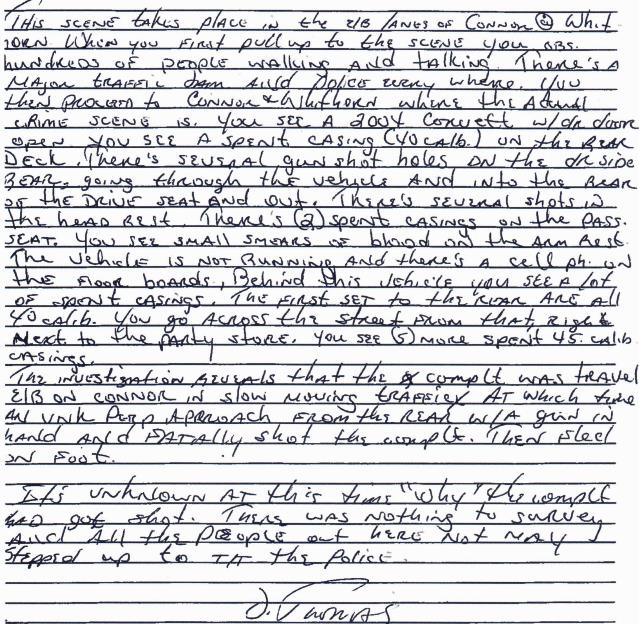
PAGE FROM INVESTIGATOR’S REPORT AT SCENE SAYS CASING ON REAR OF CORVETTE WAS 40 CAL., NOTES NUMEROUS .45 CAL. CASINGS IN PARKING LOT WHERE POLICE CAR/MARAUDER COLLISION TOOK PLACE.
Also during cross examination, Little admitted to Dezsi that a white tag identifying a 9 mm casing inside an envelope was generated when she picked up evidence from the police property office “a couple of months ago.” She agreed that a 9 mm shell casing was included on a property room inventory report Sept. 16, 2004.
“Does that lead you to believe that as far back as Sept. 16. 2004, somebody had logged in a 9 mm casing, although you testified the last time you thought it was a data entry error?” Dezsi asked Little. “Did this make you believe there was evidence that a 9 mm casing was found at the scene?”
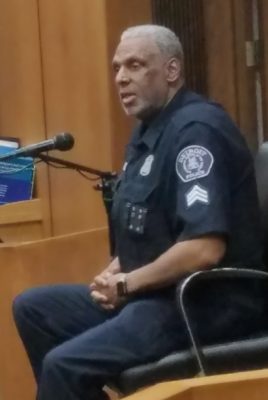
Officer in Charge Sgt. William Anderson on stand May 15, 2018
Little responded in the affirmative.
Sgt. William Anderson, who was working in the Homicide Unit at the time of the Segars killing, and became the Chief Investigative Officer in the case, took the stand next.
“On the night of the shooting I was one of the investigators at the scene,” Anderson told Chambers. “Regarding Prosecutor’s Exhibit 16, it is a Detroit interoffice memo addressed to me from Kathy Christian Asst. Corp. Counsel. I don’t recall getting it. It does make reference to the case number [in the Segars homicide] 04-289.”
Anderson read the memo, shown below, into the record. Atty. Christian is deceased and was not available to testify.
“It does not sound like the scene I responded to,” Anderson said. “We were there for quite some time. I never saw a dead woman there. I have no idea of what Kathy Christian was talking about.”
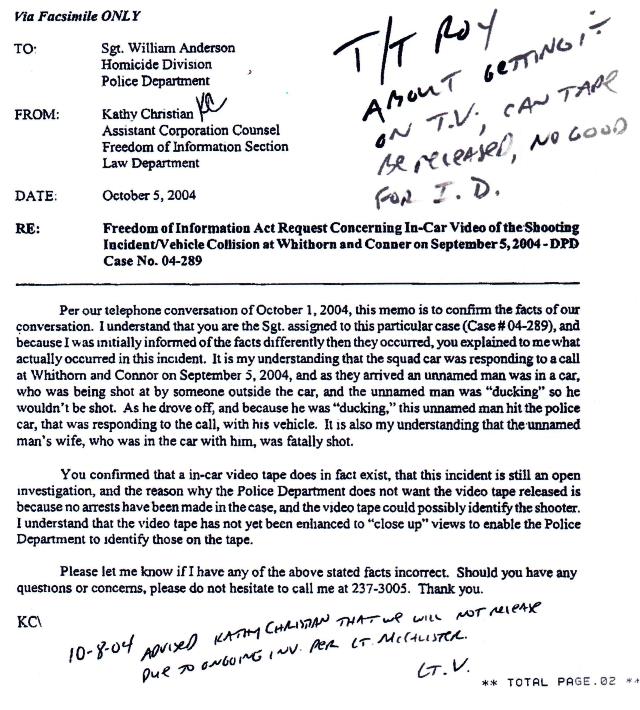
Anderson said the DPD keeps books with yearly lists of homicides. He said each listing has a number, name of complainant [deceased], location of crime, fatal or non-fatal, cause of death, homicide file number, and detectives assigned.
On cross, Dezsi asked him, “Does this book just include Detroit –not Macomb, Oakland, or Washtenaw County?”
Anderson responded in the affirmative.

2004 Mercury Marauder
Dezsi told VOD after the hearing that he was raising the possibility that the burgundy Marauder driver referred to in the memo may have taken the victim to a hospital outside of Detroit if he had a criminal record, and the fatality would not have appeared in the Detroit journal.
Dezsi then introduced into evidence a police report regarding a police car collision with the burgundy Marauder.
The report indicated that as the “crew was approaching a burgundy Mercury Marauder, it sped up, hit the police car, and sped away.”
“Some of your officers in an unmarked car were involved in a collision with another car, which is what the letter from Kathy Christian says to you,” Dezsi said to Anderson, who reiterated that he didn’t recall seeing that letter.
“You were the officer in charge,” Dezsi reminded Anderson. “You sat through most of the trial, and were present for witness interviews leading up to the trial. You don’t remember Kathy Christian’s letter that someone else was fatally shot in the car that struck the police car?”
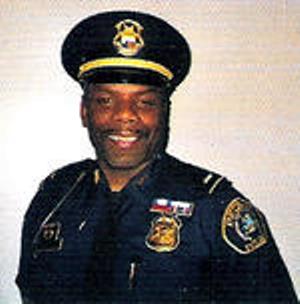
Lt. Roy McCalister Jr. is now a Detroit City Council member.
Dezsi noted a handwritten notation on the letter “TT—talked to Roy about getting it on TV—can the tapes be released,” and a note at the bottom dated Oct. 8, 2004 that “we will not release due to the ongoing investigation.”
Anderson said handwritten initials on the bottom of the note belonged to Lt. Roy McAlister and Lt. Ventavogel, but that there were no notes from him.
“Do you see anywhere where [those officers] advised Ms. Christian that her statement was not correct, anything like that,” Dezsi asked. “No notation challenging or questioning Ms. Christian’s remark that there was a second fatality at the crime scene?”
Anderson responded in the negative.
“ I was interviewing people all through the scene; I spent several hours there,” Anderson said. “Had there been another shooting, I would have been concerned about the officers’ well-being. I don’t know if another incident occurred much earlier or much later. While we were there, there was nothing referenced in the [letter.]”
Deszi then introduced a written statement by witness Latasha Boatwright, which he said she also testified to at Searcy’s preliminary exam.
“She said the police started shooting at the driver,” Dezsi said. “Do you have any recollection of the fact that the police were shooting at the car that left the scene? They weren’t shooting at the decedent [Segars]. What do you interpret her statement to say?”

Jamal Segars was driving a Corvette convertible like this, with the top down, according to Vincent Smothers.
Anderson replied,“It says the Marauder was in the gas station, then turned out of the parking lot.[She] heard shooting and he took off. [She] saw the shooter standing in the middle of the street about ten feet from the Corvette; the police were stuck in traffic. By the time the Marauder and the police car hit, the guy was up on the Corvette still shooting into it, and the passenger jumped out and ran.”
Then Anderson read a key portion of the statement: “The police started shooting at the driver. I only saw one officer, the passenger, shooting. People in the parking were running away from him.”
Deszi asked, “[So] the police were shooting at the driver. What driver—the Corvette, the Marauder, or was it a different driver?”
Anderson said that was not clear.
Following up, Dezsi asked, “Kathy Christian says in her letter that there was a second fatality in the car that hit the cop car. A witness statement says police were shooting at the driver. At no time did you investigate these statements? Were you interested in knowing that the police were shooting that night? The officers testified at trial that they did not discharge their weapons. You did not take any steps to find out whether those statements were accurate?”
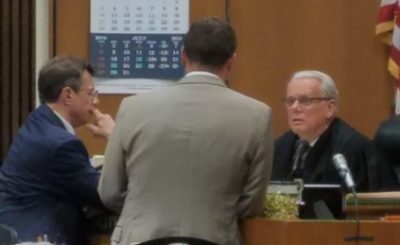
Judge Timothy Kenny (r) holds sidebar conference with AP Chambers and Atty. Dezsi at conclusion of hearing.
Anderson responded that there were no shell casings recovered that would indicate the officers fired their guns, and that he would have called in a second investigative team if that had been the case.
Dezsi then asked Anderson if he had reason to believe that a 9 mm shell casing was collected from the scene, referencing the inventory and evidence tag Sgt. Little identified.
Anderson replied in the affirmative. Dezsi also asked about Kenny’s note to the jury and the fact that bullets found in Segars’ body were identified as .40 caliber.
Dezsi then asked Anderson if he recalled testimony that a .45 caliber gun was found when Searcy was arrested at his grandmother’s home.
“Now we’ve heard that the bullet that was opened was established to be a .40 caliber. Would you agree that the gun that was offered as evidence against Mr. Searcy could not have been the gun that killed Segars?”
Asst. Prosecutor Chambers interjected that a .45 cal shell casing found on the trunk of Segars’ car matched the gun found in Searcy’s [grandmother’s] house.
Smothers earlier testified on the stand and in written affidavits that his accomplice Jeffery Daniels had a .45 caliber gun that he fired into the air during the City Airport killing.
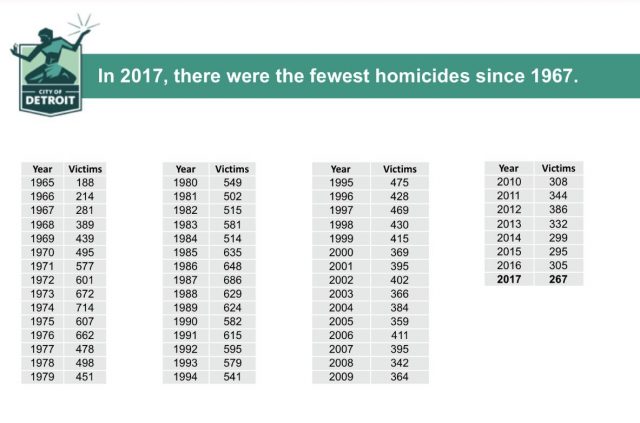
City graph shows 384 homicides in 2004.
During the trial, Searcy’s relatives testified that Daniels had left the gun at Searcy’s grandmother’s house after taking her to the supermarket, and that it did not belong to Searcy. The investigator’s report shown above references a number of .45 caliber shell casings found in the parking lot where the Marauder collision occurred. Detroit police officers regularly use .45 caliber bullets.
Judge Kenny asked that the prosecution locate the DPD homicide journal for 2004, and said that he felt that both sides should be able to come to an agreement about the second alleged homicide after studying that book. He asked that both sides submit their briefs summarizing their positions to him by June 15. He admitted both the police report about the collision with the Marauder and the Boatwright statement into evidence. He announced a motion hearing date of June 29.
Kenny also released his writ on Searcy, sending him back to the Thumb Correctional Facility and out of terrible conditions in the Wayne County Jail. Searcy waved to his dozens of supporters as he left the courtroom.
Related stories:




